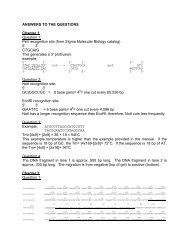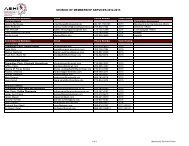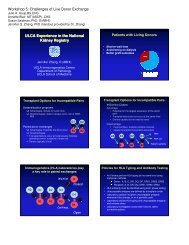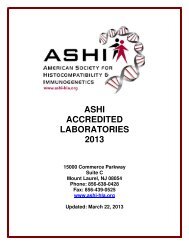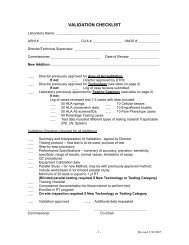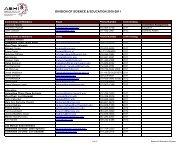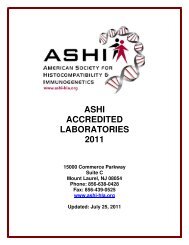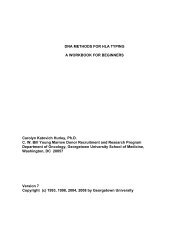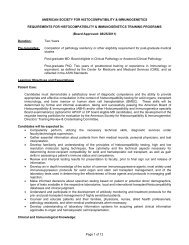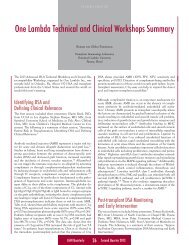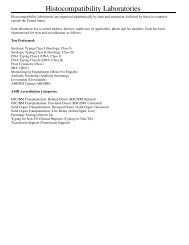Monday, September 27, 2010 2:00 PM - American Society for ...
Monday, September 27, 2010 2:00 PM - American Society for ...
Monday, September 27, 2010 2:00 PM - American Society for ...
- No tags were found...
Create successful ePaper yourself
Turn your PDF publications into a flip-book with our unique Google optimized e-Paper software.
57-PVIRTUAL CROSSMATCH SIGNIFICANTLY INCREASES ACCESS FOR SENSITIZEDPATIENTS TO HEART TRANSPLANTATION.Qiuheng Zhang 1,3 , Britt Jonathan 1,3 , Michael J. Cecka 1,3 , David W. Gjertson 1,3 , Jon Kobashigawa 2,3 , AbbasArdehali 2,3 , Elaine F. Reed 1,3 . 1 Department of Pathology and Laboratory Medicine, UCLA ImmunogeneticsCenter; 2 Division of Cardiology; 3 David Geffen School of Medicine at UCLA, Los Angeles, CA, USA.Aim: Presensitization to HLA is a major barrier to heart transplantation. Recent advances in solid-phasetesting allow identification of anti-HLA antibodies with high sensitivity and specificity. This permitsaccurate crossmatch prediction and increases the transplantation of sensitized heart candidates and the useof hearts from distant regions.Methods: 238 patients transplanted from January 2<strong>00</strong>6 to July 2<strong>00</strong>9 were analyzed retrospectively;158heart recipients were transplanted based on flow cytometry crossmatches (FCXM) alone prior toimplementation of the virtual crossmatch (vXM) in June 2<strong>00</strong>8, and since then 80 patients were transplantedaccording to vXM.Results: There were significantly more sensitized (PRA > 0%) patients transplanted by vXM (24/80, 30%)than during the previrtual period (28/158, 18%; p = 0.01). The previrtual transplant rate was 62% comparedto 75% with a vXM in the first year. In addition, 71/158 (45%) donors were imported from outside OPO inthe previtrual period compared to 40/80 (50%) in the vXM period. There was no significant difference inwaitlist mortality between the 2 periods. A comparison between actual FCXM with vXM showed that vXMaccurately predicted all crossmatch results. 20/82 vXM patients had a positive FCXM, 12 of whom had nodetectable HLA antibodies. The remaining 6 patients were presensitized to HLA but did not display anydonor-specific antibodies to HLA. 13/20 patients’ FCXM results were rendered negative with pronasetreatment. Although significantly reduced, 7 patients’ FCXM remained borderline positive after pronasetreatment.Conclusions: In conclusion, the comprehensive evaluation of HLA antibodies and the application of vXMincreased the transplantability of sensitized patients and the geographic size of the donor pool.[table1]58-POBSERVED INCREASE IN MFI OF DONOR SPECIFIC ANTIBODY UPONIMPLEMENTATION OF DTT SERUM TREATMENT.Carolyn L. Fisher, Heather A. Casey, Thomas L. Bement, Michele E. Lachance, Dennis F. Habig,Kimberly J. Goss, Justine L. Gaspari, Ronald E. Domen, Hiroko Shike. HLA Laboratory, Penn StateHershey Medical Center, Hershey, PA, USA.Aim: Naturally occurring serum substances can interfere with Luminex antibody assay, particularly singleantigen beads (SAB). Efficacy of hypotonic dialysis and DTT treatment were reported to inactivate suchsubstances (Zachary 2<strong>00</strong>9; Kosmoliaptsis <strong>2010</strong>). We made similar observation and implemented DTTtreatment <strong>for</strong> Luminex assay in March <strong>2010</strong>. Observed increase in MFI of donor specific HLA antibody(DSA) upon DTT-implementation may be confused with true DSA increase, a risk indicator of antibodymediatedrejection. We evaluated the impact of DTT treatment in our post-transplant patient population.Methods: DTT treated serum (20µL 50 mM DTT + 180 µL serum) was tested by One Lambda LABScreenPRA Class I and II and LABScreen Single Antigen. Average DSA MFI from the last four consecutiveresults without DTT was compared with the first result after DTT implementation.Results: DSA has been detected by SAB <strong>for</strong> over a year in seven patients 2.3 to 15 years post kidneytransplant. One patient had Class I and II DSA and six patients had Class II DSA only. DSA-MFI (range:3,4<strong>00</strong> – 13,<strong>00</strong>0) were stable be<strong>for</strong>e DTT implementation (CV of 1-28% in last four dates tested). AfterDTT implementation, DSA-MFI increased >1.5x by SAB but not by PRA beads in 5 patients. One patienthad increased DSA-MFI (2.2x) by PRA beads only. One patient had no changes by both SAB and PRAbeads. None presented antibody mediated rejection. Observed increase in DSA-MFI was attributed to DTTimplementation. Retrospectively, positive control bead MFI was not in<strong>for</strong>mative in predicting increasedDSA-MFI after DTT-treatment.Conclusions: DTT-treatment can increase MFI of Luminex-based HLA antibody detection including DSA-MFI. Observed increase in DSA-MFI coinciding with DTT-implementation should be communicated toclinicians to prevent a false alert. Once DTT is implemented, consistency in assay procedure is critical inpost-transplant monitoring.



